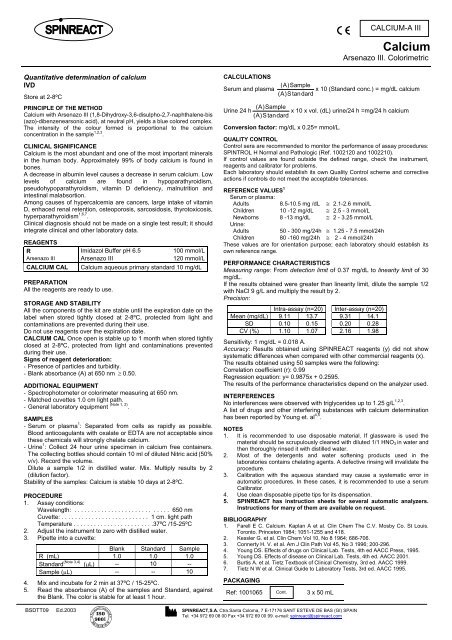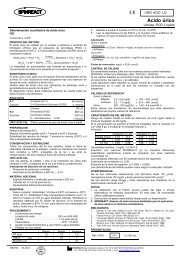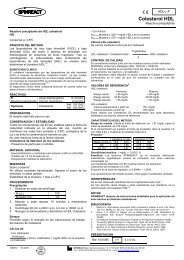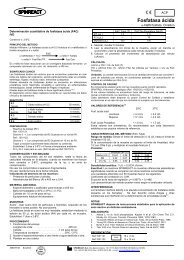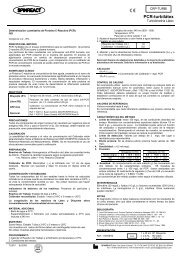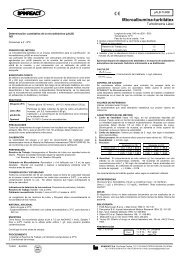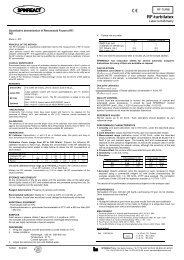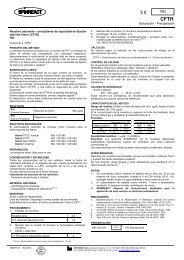You also want an ePaper? Increase the reach of your titles
YUMPU automatically turns print PDFs into web optimized ePapers that Google loves.
Quantitative determination of calcium<br />
IVD<br />
Store at 2-8ºC<br />
PRINCIPLE OF THE METHOD<br />
Calcium with Arsenazo III (1,8-Dihydroxy-3,6-disulpho-2,7-naphthalene-bis<br />
(azo)-dibenzenearsonic acid), at neutral pH, yields a blue colored complex.<br />
The intensity of the colour formed is proportional to the calcium<br />
concentration in the sample 1,2,3 .<br />
CLINICAL SIGNIFICANCE<br />
Calcium is the most abundant and one of the most important minerals<br />
in the human body. Approximately 99% of body calcium is found in<br />
bones.<br />
A decrease in albumin level causes a decrease in serum calcium. Low<br />
levels of calcium are found in hypoparathyroidism,<br />
pseudohypoparathyroidism, vitamin D deficiency, malnutrition and<br />
intestinal malabsortion.<br />
Among causes of hypercalcemia are cancers, large intake of vitamin<br />
D, enhaced renal retention, osteoporosis, sarcosidosis, thyrotoxicosis,<br />
hyperparathyroidism 1,6,7 .<br />
Clinical diagnosis should not be made on a single test result; it should<br />
integrate clinical and other laboratory data.<br />
REAGENTS<br />
R<br />
Arsenazo III<br />
Imidazol Buffer pH 6.5<br />
Arsenazo III<br />
100 mmol/L<br />
120 mmol/L<br />
CALCIUM CAL Calcium aqueous primary standard 10 mg/dL<br />
PREPARATION<br />
All the reagents are ready to use.<br />
STORAGE AND STABILITY<br />
All the components of the kit are stable until the expiration date on the<br />
label when stored tightly closed at 2-8ºC, protected from light and<br />
contaminations are prevented during their use.<br />
Do not use reagents over the expiration date.<br />
CALCIUM CAL Once open is stable up to 1 month when stored tightly<br />
closed at 2-8ºC, protected from light and contaminations prevented<br />
during their use.<br />
Signs of reagent deterioration:<br />
- Presence of particles and turbidity.<br />
- Blank absorbance (A) at 650 nm ≥ 0.50.<br />
ADDITIONAL EQUIPMENT<br />
- Spectrophotometer or colorimeter measuring at 650 nm.<br />
- Matched cuvettes 1.0 cm light path.<br />
- General laboratory equipment (Note 1, 2) .<br />
SAMPLES<br />
- Serum or plasma 1 : Separated from cells as rapidly as possible.<br />
Blood anticoagulants with oxalate or EDTA are not acceptable since<br />
these chemicals will strongly chelate calcium.<br />
- Urine 1 : Collect 24 hour urine specimen in calcium free containers.<br />
The collecting bottles should contain 10 ml of diluted Nitric acid (50%<br />
v/v). Record the volume.<br />
Dilute a sample 1/2 in distilled water. Mix. Multiply results by 2<br />
(dilution factor).<br />
Stability of the samples: Calcium is stable 10 days at 2-8ºC.<br />
PROCEDURE<br />
1. Assay conditions:<br />
Wavelength: . . . . . . . . . . . . . . . . . . . . . . . . . . . . 650 nm<br />
Cuvette: . . . . . . . . . . . . . . . . . . . . . . . . . . 1 cm. light path<br />
Temperature . . . . . . . . . . . . . . . . . . . . . . . .37ºC /15-25ºC<br />
2. Adjust the instrument to zero with distilled water.<br />
3. Pipette into a cuvette:<br />
Blank Standard Sample<br />
R (mL) 1.0 1.0 1.0<br />
Standard (Note 3,4) (µL) -- 10 --<br />
Sample (µL) -- -- 10<br />
4. Mix and incubate for 2 min at 37ºC / 15-25ºC.<br />
5. Read the absorbance (A) of the samples and Standard, against<br />
the Blank. The color is stable for at least 1 hour.<br />
CALCULATIONS<br />
Serum and plasma<br />
Urine 24 h<br />
( A)<br />
Sample<br />
( A)<br />
S tandard<br />
( A)<br />
Sample<br />
( A)<br />
S tandard<br />
Conversion factor: mg/dL x 0.25= mmol/L.<br />
BSDTT09 Ed.2003 SPINREACT,S.A. Ctra.Santa Coloma, 7 E-17176 SANT ESTEVE DE BAS (GI) SPAIN<br />
Tel. +34 972 69 08 00 Fax +34 972 69 00 99. e-mail: spinreact@spinreact.com<br />
CALCIUM-A III<br />
Calcium<br />
Arsenazo III. Colorimetric<br />
x 10 (Standard conc.) = mg/dL calcium<br />
x 10 x vol. (dL) urine/24 h =mg/24 h calcium<br />
QUALITY CONTROL<br />
Control sera are recommended to monitor the performance of assay procedures:<br />
SPINTROL H Normal and Pathologic (Ref. 1002120 and 1002210).<br />
If control values are found outside the defined range, check the instrument,<br />
reagents and calibrator for problems.<br />
Each laboratory should establish its own Quality Control scheme and corrective<br />
actions if controls do not meet the acceptable tolerances.<br />
REFERENCE VALUES 1<br />
Serum or plasma:<br />
Adults 8.5-10.5 mg /dL ≅ 2.1-2.6 mmol/L<br />
Children 10 -12 mg/dL ≅ 2.5 - 3 mmol/L<br />
Newborns 8 -13 mg/dL ≅ 2 - 3.25 mmol/L<br />
Urine:<br />
Adults 50 - 300 mg/24h ≅ 1.25 - 7.5 mmol/24h<br />
Children 80 -160 mg/24h ≅ 2 - 4 mmol/24h<br />
These values are for orientation purpose; each laboratory should establish its<br />
own reference range.<br />
PERFORMANCE CHARACTERISTICS<br />
Measuring range: From detection limit of 0.37 mg/dL to linearity limit of 30<br />
mg/dL.<br />
If the results obtained were greater than linearity limit, dilute the sample 1/2<br />
with NaCl 9 g/L and multiply the result by 2.<br />
Precision:<br />
Intra-assay (n=20) Inter-assay (n=20)<br />
Mean (mg/dL) 9.11 13.7 9.31 14.1<br />
SD 0.10 0.15 0.20 0.28<br />
CV (%) 1.10 1.07 2.16 1.98<br />
Sensitivity: 1 mg/dL = 0.018 A.<br />
Accuracy: Results obtained using SPINREACT reagents (y) did not show<br />
systematic differences when compared with other commercial reagents (x).<br />
The results obtained using 50 samples were the following:<br />
Correlation coefficient (r): 0.99<br />
Regression equation: y= 0.9875x + 0.2595.<br />
The results of the performance characteristics depend on the analyzer used.<br />
INTERFERENCES<br />
No interferences were observed with triglycerides up to 1.25 g/L 1,2,3 .<br />
A list of drugs and other interfering substances with calcium determination<br />
has been reported by Young et. al 4,5 .<br />
NOTES<br />
1. It is recommended to use disposable material. If glassware is used the<br />
material should be scrupulously cleaned with diluted 1/1 HNO3 in water and<br />
then thoroughly rinsed it with distilled water.<br />
2. Most of the detergents and water softening products used in the<br />
laboratories contains chelating agents. A defective rinsing will invalidate the<br />
procedure.<br />
3. Calibration with the aqueous standard may cause a systematic error in<br />
automatic procedures. In these cases, it is recommended to use a serum<br />
Calibrator.<br />
4. Use clean disposable pipette tips for its dispensation.<br />
5. SPINREACT has instruction sheets for several automatic analyzers.<br />
Instructions for many of them are available on request.<br />
BIBLIOGRAPHY<br />
1. Farell E C. Calcium. Kaplan A et al. Clin Chem The C.V. Mosby Co. St Louis.<br />
Toronto. Princeton 1984; 1051-1255 and 418.<br />
2. Kessler G. et al. Clin Chem Vol 10, No 8 1964; 686-706.<br />
3. Connerty H. V. et al. Am J Clin Path Vol 45, No 3 1996; 200-296.<br />
4. Young DS. Effects of drugs on Clinical Lab. Tests, 4th ed AACC Press, 1995.<br />
5. Young DS. Effects of disease on Clinical Lab. Tests, 4th ed. AACC 2001.<br />
6. Burtis A. et al. Tietz Textbook of Clinical Chemistry, 3rd ed. AACC 1999.<br />
7. Tietz N W et al. Clinical Guide to Laboratory Tests, 3rd ed. AACC 1995.<br />
PACKAGING<br />
Ref: 1001065 Cont.<br />
3 x 50 mL


